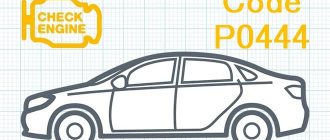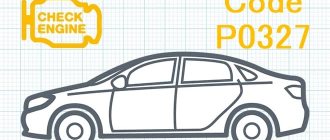The car's electronic system is equipped with a function for recognizing errors in the operation of many components and mechanisms, so if you have technical problems, you should definitely pay attention to the instrument panel. In addition to the Check Engine light coming on, information about problems can be transmitted in encrypted form. The code usually consists of letters and symbols, therefore, without knowing the exact meaning of such a “message”, it is impossible to take any action to improve the situation. If the car’s engine begins to operate unstably, the car’s technical condition monitoring system displays error p0300, but analogues of such a message can also be codes like p03xx in which “x” can be replaced with a number.
What does error P0030 mean?
Error P0030 occurs in cases where the ECM detects an incorrect formation of the air-fuel mixture or an open circuit of the lambda heater 1 (bank 1) to the converter.
Conditions for fixing error P0030
This error is recorded in the ECU memory only under the following conditions:
- The motor is running.
- The self-diagnosis system detected a lack of reference voltage in the electrical circuit of the oxygen sensor heater.
- This malfunction occurs during 2 drive cycles (sequence: ignition off - ignition on - engine starts - driving, stopping - ignition off).
- On the HO2S heater, the resistance is less than 3 ohms or greater than 35 ohms.
- The temperature of the catalytic converter is above 300°C.
The conditions for recording an error with code p0030 are relevant for almost all cars where two oxygen sensors are installed (control and diagnostic). In particular, it can be found on: VAZ, Ford, Hyundai, Kia, VW, Peugeot, Chevrolet, Subaru, Skoda, Mazda, Citroen and BMW.
Diagnostics
Error on display - misfire
An unpleasant situation when a motorist comes to the car, starts it, but cannot move off normally because it begins to twitch. This means that there are problems with the ignition.
Diagnosing a malfunction is quite easy, because the electronic engine control unit immediately recognizes the error.
Before you get into the ECU, you should look to see if the “ Check Engine ” light has come on on the instrument panel. So, this is a signal that errors have appeared in the operation of the main power unit. If the “brains” controller is equipped with a display located on the instrument panel, then the error can be determined immediately.
Signs of trouble
Basically, code P0030 is accompanied by the following deviations in normal engine operation:
- The Check lamp is constantly on;
- fuel consumption increases significantly;
- engine power decreases;
- when accelerating, the engine begins to slow down and transmits thrust jerkily;
- The control unit puts the car into emergency mode - the crankshaft speed is limited to 3000 rpm, and in some cases the speed may be limited to 30-60 km/h.
In addition, the error often appears in conjunction with other codes that either simply duplicate it or indicate the presence of related faults. Error code P0032 in place of P0030 may be displayed more often than others, as it indicates a malfunction of the heater itself. As a result of heater failure, the system registers a reference voltage of 0.9 V that is too high, as if the mixture is too rich (the norm is 0.45 V).
Display of auxiliary error P0032
Displays two errors simultaneously: P0030 and P0134
The table below shows the most common codes that can be displayed simultaneously with the obd error P0030 on different vehicles:
| Error code | Decoding |
| P0031 | Oxygen sensor to the neutralizer, checking the short circuit of the heater circuit “to ground” |
| P0032 | Oxygen sensor 1 heating circuit voltage too high |
| P0036 | Malfunction in the oxygen sensor 2 heater circuit (bank 1) |
| P0037 | Oxygen sensor after the converter, checking the short circuit of the heater circuit “to ground” |
| P0038 | Oxygen sensor after the converter, short circuit |
| P0050 | Oxygen Sensor Heater 1 Bank 2 - Circuit Malfunction |
| P0053 | Heating resistor of the first lambda probe, incorrect resistance |
| P0054 | Heating resistor of the second lambda probe, incorrect resistance |
| P0057 | Heated Oxygen Sensor 2 Bank 2 Heater Control - Heater Circuit Low Voltage |
| P0134 | Low level of oxygen sensor signal, UDC circuit is not active |
| P0141 | O2 Sensor Heater 2 Bank 1 - Circuit Malfunction |
| P0172 | Too rich mixture (rarely displayed, mainly on Subaru) |
| P2251 | Lambda probe 1, bank 1, ground cable open circuit |
| P2626 | Heated Oxygen Sensor 1 Bank 1 Pump Current - Open Circuit |
How to understand that there are multiple misfires on cylinders
You can understand that there is a misfire in the cylinders by the following signs:
- Presence of detonation.
- The engine became difficult to start.
- Reduced power.
- Dips when accelerating.
- Increased engine vibration during operation.
Depending on the reason that caused deviations in engine operation, the exhaust gases may also turn black. A misfire will certainly have a negative impact on the economic performance of the power plant.
Reasons for the error
If the diagnostic scanner detected code P0030 immediately 30 seconds after the engine started, this may indicate several common causes.
Main reasons:
- A break in the wire of the first lambda sensor or lack of contact in its connector.
- The lambda wire is shorted to ground.
- The sensor heater fuse has blown (mostly installed on VAG models).
- The oxygen sensor heater itself is faulty - check the resistance (should be no less than 3 Ohms and no more than 35 Ohms).
- The type of sensor does not match the standard one installed from the factory - check and replace with a suitable one. This problem often occurs on Subaru cars when an analogue lambda is installed; the error can be eliminated only after replacing it with the original.
- The data bus to the controller that controls the sensor is faulty. Or an incompatible controller is installed - replace the ECU.
- The controller has the wrong firmware installed.
Where to look for a fault
In some cases, the P0030 code may be displayed without any disturbance in the vehicle's dynamics. All systems are working normally, the flow rate does not change, but the code is generated. In this case, you need to check several main possible causes of the error:
- The wire may break in the area from the probe to the connecting block. You need to disconnect the connector and check the contacts with a multimeter. If the sensor is in order, then it should ring without problems.
- The wire in the area from the connecting block to the ECM may be frayed or one contact may be broken. You also need to remove the wire and check whether the contact is coming to the block - whether there is resistance.
- The problem is in the block itself. For example, the VAZ 2114 has the 2111-1411020-81 January 7.2 unit installed, which is characterized by the problem of the TLE6240GP B1 chip burning out. To solve the problem, you will have to take the unit to a specialist so that he can resolder this microcircuit, since they can often fail. The price of the microcircuit itself is on average from 300 to 500 rubles.
VAZ error codes - the most common problems and their reflection
Almost all modern cars are equipped with excellent on-board computers that can fully diagnose important systems and technical components of the vehicle. When a breakdown known to the computer occurs, the driver receives on the screen a certain set of numbers and letters, which is called an error code. The first computers installed on domestic cars of the VAZ corporation simply produced general errors, illuminating the Check Engine light even in cases of minor problems. Today, computers are smarter and can accurately describe the problem that has arisen.
Unfortunately, VAZ error codes are far from ideal. Sometimes a problem with the battery or generator is displayed as a serious engine failure. Therefore, you should not immediately pick up a calculator and start calculating the amount of repair costs. First you need to diagnose the problem and get more information about what is happening under the hood of your car. Today we will talk about some specific error codes and discuss the features of various problems.
Basics of error codes on VAZ cars - diagnosable components
Today, cars from domestic manufacturers across the entire model range are equipped with the necessary computer diagnostic systems. But these systems are far from ideal, and even the designers of the plant itself admit this. General sensors are used as the basis for identifying problems; these systems do not provide any specific data in the event of a breakdown.
Demonstration of problems with your car is based on some functions, so the codes cannot show the exact problem. For example, there are several sensors on the engine air supply system. Oxygen and its consumption can indeed indicate problems with the unit, but this is not always accurate. The most serious error codes that you should pay special attention to are the following:
- problems with the on-board electrical network - codes P0562 and P0563 indicate low and high voltage levels, respectively;
- codes P0506 and P0507 indicate incorrect idle speed settings - too low and too high;
- four codes indicate a malfunction in one of the cylinders - P1301, P1302, P1303, P1304;
- also four codes are responsible for malfunctions of the injectors on each cylinder - P0201, P0202, P0203, P0204;
- an extremely important code, after which it is better to stop operation - an indicator of increased engine temperature P0217;
- The P0300 code is often a harbinger of the need for major repairs, because it means random fuel misfires.
Most codes are related to the operation of sensors, because this is the easiest way to build a car diagnostic system. Nevertheless, this approach has proven to be effective for owners of domestic cars, because now you can know for sure that some kind of problem has occurred with the car. It no longer makes sense to fix the problem yourself; the car system has become much more complicated.
Therefore, after receiving information about a malfunction, it is best to visit a car service center and carry out diagnostics. Service stations never rely solely on on-board computer data. Often, an independent check of all systems is carried out and the presence of problems is determined by the behavior of the car, the owner’s testimony and other important criteria.
How to find a fault
Checking the positive contact of the oxygen sensor heater
First of all, it is worth checking the voltage in the connecting block of the first lambda and the presence of oxides; it happens that after cleaning the contact with a special product, the problem goes away. It is also worth checking the performance of the sensor itself by measuring the resistance.
To check the lambda probe wire, you need to disconnect two parts of the connecting block. We do not touch the part that goes down to the “female” sensor, but take measurements on the “male” block, the wires of which lead to the ECU.
With the ignition on, use a multimeter to check what voltage is supplied through the wires from the computer to the sensor heating element. To do this, select the voltage measurement mode of 20 V on the device and take readings on the contacts one by one. We attach the black probe to ground to the body, and connect the red probe to the upper right contact (if the block is not twisted, this will be the positive contact of the sensor heater). It should show a little more than 12 V. The diagonally opposite, lower left contact also goes to the heater and it should show a voltage of no more than 3.27 V.
When connected to the upper left contact, the multimeter will show a very small value - 0.02 V. After this, connect the probe to the opposite, lower right contact - there the voltage should be about 0.45 V. This is the contact of the oxygen sensor, which analyzes the level of oxygen in the exhaust gases and transmits the reference voltage directly to the ECU. After this, the system adjusts the fuel-air mixture based on the data received.
The oxygen sensor reference voltage should always be checked with the engine warm!
You can also check the male block by selecting the ringing mode on the multimeter. If all contacts ring, then the wire is in normal condition, and the problem most likely lies in the oxygen sensor itself.
To check the lambda probe itself, select the resistance measurement mode of 200 Ohms on the multimeter. We connect the red probe to the upper right contact, and the black one to the lower left , both go to the lambda heater (on most cars these wires are white). Normally, the resistance of the working sensor should be 3.3-3.5 Ohms. More details about checking the lambda probe can be found using the example of Ford Mondeo 1 here.











